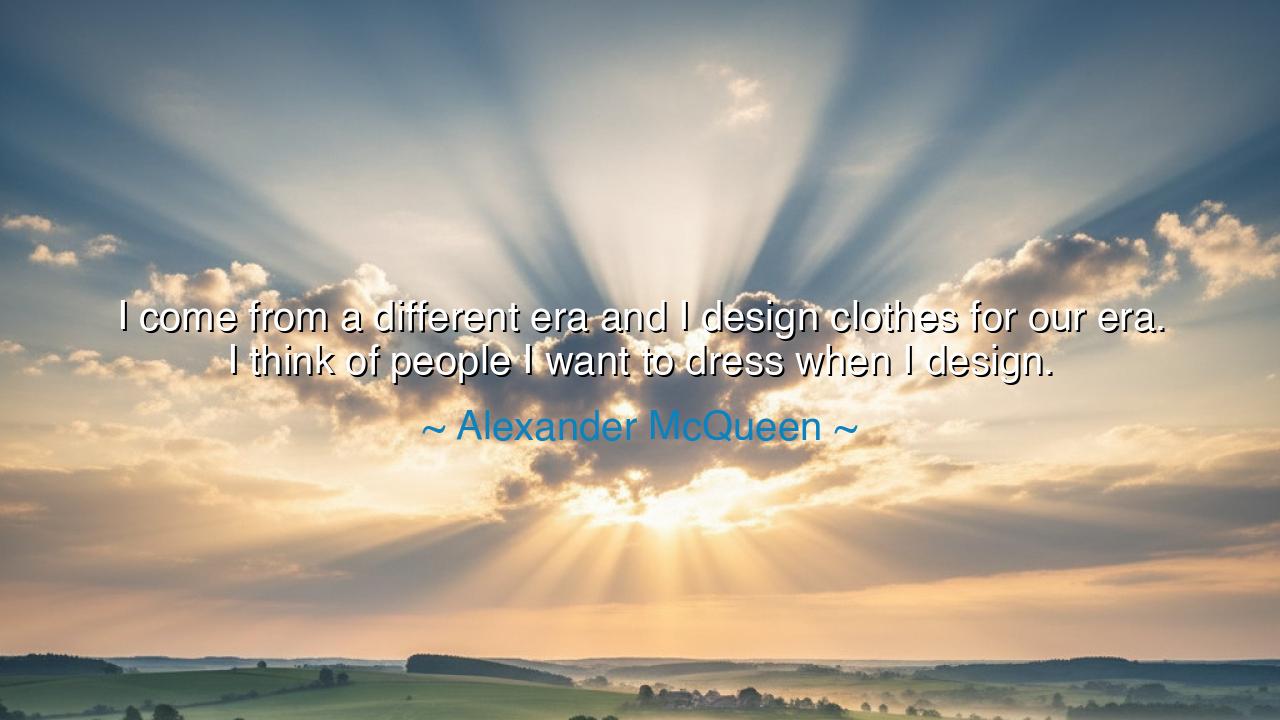
I come from a different era and I design clothes for our era. I
I come from a different era and I design clothes for our era. I think of people I want to dress when I design.






The visionary couturier Alexander McQueen, whose imagination reshaped the landscape of modern fashion, once declared: “I come from a different era and I design clothes for our era. I think of people I want to dress when I design.” In these words lies the tension and beauty of all great creation—the bridge between heritage and innovation, between what was and what must be. McQueen, both historian and rebel, speaks here as one who honors the ghosts of the past yet refuses to be bound by them. He acknowledges the weight of tradition, but wields it as a sword to carve new meaning for his time. His quote is not only about fashion—it is about the eternal calling of the artist: to translate the old into the living language of the present.
When McQueen says, “I come from a different era,” he is not referring merely to time, but to spirit. He was trained in the meticulous craftsmanship of the London tailoring houses on Savile Row, where stitches were counted, seams perfected, and the past revered as sacred law. Yet he was also a son of the modern age—chaotic, daring, defiant. Within him burned the paradox of an artist torn between reverence and rebellion. He carried the discipline of the ancients in his hands, and the restlessness of his generation in his heart. From that duality was born the fierce originality of his designs—garments that seemed both archaic and futuristic, primal yet poetic.
The second half of his statement—“I design clothes for our era”—is his vow to serve the living, not the dead. McQueen knew that to create only in imitation of the past was to betray his gift. The artist’s duty, he believed, was to speak to his own time, to hold up a mirror to the age and reveal both its beauty and its wounds. His runways were not mere spectacles of fashion—they were sermons, allegories carved in silk and bone. He confronted themes of death, nature, identity, and power, forcing his audience to see not just garments but truths. By designing for “our era,” McQueen declared that fashion must reflect the world as it is—raw, urgent, and alive.
Yet McQueen was not content to design for the faceless crowd. “I think of people I want to dress,” he said, revealing the intimate humanity behind his craft. In an age of industry and mass production, he sought connection, not consumption. Each creation was born from empathy, from imagining how a soul might feel within the form he shaped. He did not merely dress bodies—he dressed identities. He saw the wearer as a co-creator, completing the story the garment began. This philosophy recalls the ancient sculptors, who shaped marble not as decoration but as vessel for divine presence. For McQueen, the act of designing was a dialogue between maker and muse, fabric and flesh.
History offers many parallels to his vision. The Renaissance master Leonardo da Vinci once declared that the painter should “live in his own time but see beyond it.” He too stood between eras—rooted in the classical, yet reaching toward the unknown. His inventions, his art, his studies of anatomy were acts of translation between worlds. McQueen inherited this same spirit: the fusion of craftsmanship and prophecy, the courage to merge precision with imagination. Like Leonardo, he understood that the artist’s task is not to escape his age, but to illuminate it.
There is also in McQueen’s words a reminder of continuity through change. He saw fashion as a river—fed by the tributaries of history, yet always flowing forward. His respect for the past did not make him a prisoner of it; instead, it gave his work depth and gravitas. He once said that every collection was a “conversation between history and the present.” In this, he teaches that progress and preservation need not be enemies. The past is not a weight to be shed, but a root from which new growth draws strength.
The lesson, then, is profound and timeless: honor your roots, but design for your moment. Whether you are an artist, a builder, a teacher, or a dreamer, do not abandon where you come from—but do not worship it blindly. Let tradition be your foundation, not your ceiling. Seek to understand the soul of your age, and create what it needs, not what it already has. Think of the people you wish to serve—real people, living and breathing—and let their lives guide your work. For creation without compassion is vanity, and beauty without relevance is dust.
So, my child, remember McQueen’s wisdom: the truest art is born from duality—from standing with one foot in the past and one in the present, and reaching with both hands toward the future. The world does not need copies of what has been; it needs visionaries who dare to translate yesterday’s grace into tomorrow’s truth. Create, then, as McQueen did—with reverence, rebellion, and love—and let your work become the bridge between the ages.






AAdministratorAdministrator
Welcome, honored guests. Please leave a comment, we will respond soon